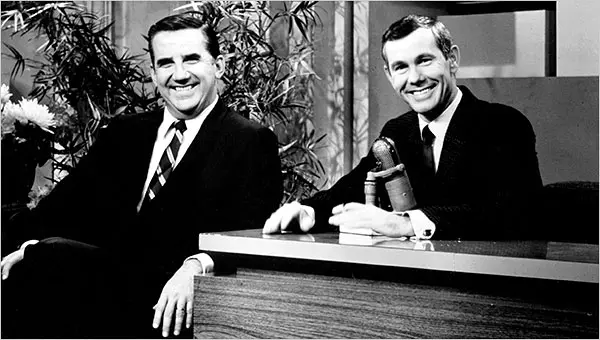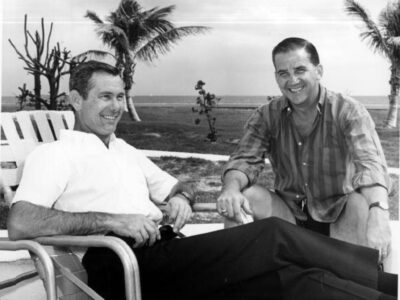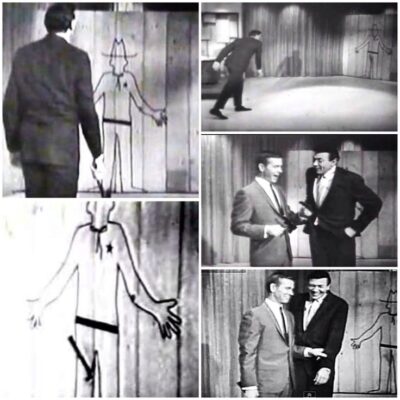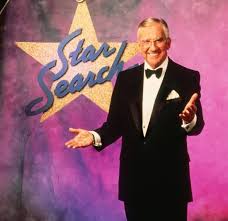“My Next Guest Needs No Introduction” is the name of the Netflix series David Letterman launched in January 2018. Those six words crystallize Ed McMa
“My Next Guest Needs No Introduction” is the name of the Netflix series David Letterman launched in January 2018.
Those six words crystallize Ed McMahon, the epitome of the word “gentleman” who graciously agreed to do a “Mike Kinosian Interview” a number of years ago when I was Inside Radio’s Special Features Editor.
At the time of our hour-long conversation, Ed was hosting Ed McMahon’s Lifestyles Live,” a 55-minute weekend program (Saturdays, 6:05 pm and Sundays, 10:05 am) carried by approximately 60 affiliates on the USA Radio Network and Mike Horn’s Cable Radio Network; it was also heard on Langer Broadcasting Network.
No one has been more positively engaging; gracious; and accommodating than this genuine Hall Of Famer; however, it was EXACTLY SIXTEEN (16) YEARS AGO TODAY (6-23-2009) when Ed McMahon died – reportedly peacefully – at the UCLA Medical Center.
He was … 86 years old.
While some references will appear dated, here nonetheless is an edited version of my chat with him.
And Now … Hear Ed
Look up “broadcaster” in the dictionary and you’ll find a picture of the effervescent Ed McMahon.
“Money in the bank;” “the real deal;” “solid as the rock of Gibraltar;” and “smooth as silk” grossly understate Johnny Carson’s longtime (“Who Do You Trust?” and “Tonight Show”) indefatigable sidekick.
Not only did McMahon exemplify the word “broadcaster,” he made the scores of us who used him as a role model absolutely bust our buttons with pride to be in the same profession. “That’s what I call myself and I hope that’s what I fulfill,” he remarked to me back then. “When I started out, I was literally too young to know what ‘broadcaster’ meant. I’d never heard the word, but – as far as I’m concerned – that’s what I am.”
Childhood Dream
Many of us can rightfully lay claim that our fascination with radio began at an early age. The same rings true with the former World War ll fighter pilot.
As much as he loved playing football, a then-10-year-old McMahon instead happily focused on what would lead to a very lucrative profession. “I’d hold a flashlight like it was a microphone and cue up old records in my grandmother’s parlor in Lowell, Massachusetts,” he vividly recalled. “There was a comic strip at that time called Prince Valiant. I reversed the name and called my dog Valiant Prince. He was very valiant, indeed, and sat at my feet and listened to me talk aloud to a flashlight. I’d read Time Magazine [and pretend I] was an air personality and newscaster.”
Even then, the future spokesman for Alpo and Budweiser read the ads as a commercial pitchman. “Subliminally, I think I was finding a way to make the most money from this business,” McMahon jested with his hearty trademark laugh. “But I loved [pretending] to be a broadcaster. I thought of myself as a guy on the radio.”
Talented Teens
That dream would be realized several years later on WLLH/Lowell, Massachusetts, where he held down a demanding 6:00 pm – 1:00 am shift.
As is typical, however, the road to getting that always-important first job wasn’t a cakewalk. “I was in high school when [WLLH] had an audition for an announcer. One of my classmates won and I came in second. He got the job, but was so good that he soon went to Boston. [Station management] remembered that I came in second and I got his job.”
Consider for a moment the incredible talent that existed inside that particular Lowell high school: The person who won the WLLH audition was a young lad named Ray Goulding. By going to Boston, he was able to meet Bob Elliott and formed one of the greatest radio teams in history. “Those two guys [Bob & Ray] were the best at using comedy on radio that I ever heard,” asserted McMahon. “They really knew how to make it work.”
Lifestyles Live
It’s understandable why the overwhelming majority of people associate the former “Star Search” host and “Bloopers & Practical Jokes” co-host with television, but as noted, McMahon’s roots are in radio. At a time when he hardly needed the exposure, the man with the rich and vibrant voice was again part of the medium he so deeply loved.
As host of USA Radio Networks’ weekly “Lifestyles Live,” McMahon profiled celebrities; one such subject was CNN’s Paula Zahn. “She has a lecture series, talks to corporate America, is happily married and raises a couple of kids,” McMahon explained. “But she’s on the air every day. She has a show to put together and has to stay in peak form. How does she do it? A mother picking up their kids at a soccer game is overwhelmed because she has to go home and make dinner. She asks herself why life is so tough and then hears about Paula Zahn.”
Expanding Problem
The show was also about doctors, athletic trainers and anyone else who could improve one’s lifestyle and make an impact on another person’s life. “When the show first started, we got on the subject of obesity,” McMahon commented. “I did ‘Star Search’ at Disney World for three years. If you go to any theme park, you can see how many people are overweight; it’s terrible. They now have to make coffins larger, stretchers stronger and cars bigger.”
As a frequent traveler, McMahon took mental notes of those around him. More than half the people he saw were overweight. “A third are obese,” he stressed. “This is going to affect our country with things like health costs and these are the [issues] we talk about.”
Concerns about weight really hit home, as McMahon was raising his sister-in-law’s then-14-year-old daughter. “My wife’s sister passed away and [my wife, Pam] and I were designated in the will to raise her. We see her facing the same problems as all other 14-year-olds. They think French fries are the greatest thing in the world and would have them for breakfast, lunch, and dinner. You have to worry about that. If they don’t curb it when they’re young, they can’t curb it when they get older. It’s something we’re very much aware of and talk about it on the air.”
Tough Struggle
In addition to making endless references about McMahon’s fondness for libations, Johnny Carson relentlessly needled his second banana about his waistline. “I fought like hell so I could be just 10 – 15 pounds overweight,” he insisted with a slightly more serious tone in his voice. “It wasn’t an easy thing for me to do.”
A much sleeker McMahon when we chatted weighed only a few pounds more than he did when he played football for the Boston College Eagles in the early-1940s. “I’m now the proper weight for my height,” he boasted. “I have to live what I preach. In addition to being entertaining, I also want to get people’s attention.”
As implausible as it seemed, the always nattily-attired McMahon was in his mid-80s when we spoke. “I just got back from visiting people at a nursing home in Orlando,” he recollected. “Some of them were in wheelchairs and couldn’t get up; they were my age. As I told them, there are a lot of dances left in these pants. People get a big kick out of that, but it’s true. I feel an obligation to help where I can. I have a chance to do this kind of show and help people be better – that’s what I love about it.”
Inspirational Show
Via the USA Radio Network; Cable Radio Network; and Langer Broadcasting Network, McMahon’s show had a pretty good reach, but it was his hope “to build a 200- or 300-station network.”
When the peerlessly-affable McMahon talked to affiliates, they invariably mentioned that they get great reaction from the show. “The idea that you’re talking about a lifestyle with celebrities is different,” the Catholic Universitygraduate emphasized. “I’m also able to get the hottest celebrities around. They raise their families, go to church, go to ballgames, live a full life and get the job done. It’s an inspiring thing to other people.”
Natural Fit
That wasn’t his only project at the time. Busier than most people half his age, “Big Ed” was actively working on a daily vignette with a simply perfect premise: His recollections of great moments in “The Tonight Show” series. Working titles included: “Memories Of The Tonight Show;” “Tonight Show Memories;” and “McMahon Remembers Tonight.” As McMahon pointed out, “People are still looking at it, but it hasn’t been sold yet. We’ve done it so I can tell the story of the dog that walked away without eating dog food during a live Alpo commercial and how Johnny came in and ate the Alpo.”
Tomahawk Chop
Countless highlights dotted Carson’s 30-year “Tonight Show” run, but none greater than an incident involving singer/actor Ed Ames, who portrayed Mingoon “Daniel Boone.”
The black-and-white clip that still occasionally surfaces is generally regarded as a bona fide television classic and features one of the longest-sustained laughs ever recorded on a TV show. “Ed Ames showed Johnny how to throw a tomahawk at a make believe cowboy and hell, he damned near killed him,” McMahon quipped as he busted into an infectious laugh.
Spontaneity Over Scripting
It’s crystal clear from the way masterful storyteller McMahon recalled the infamous story that scripts wouldn’t have been needed for these vignettes. “We’ve done about five sample shows and I’ve adlibbed most of the material,” he admitted. “We get into subject matter the same way Johnny did. He had a platform where he could address islands of conversation. But someone would say something as soon as they sat down that would propel the entire interview. He wouldn’t have to ask any prepared questions. That’s how I do my radio show – I let people take the direction. They take us where they want to go. It’s a lot easier for me, because I don’t like doing scripted shows.”
Special Bond
The thing Ed missed most about the 30-year connection with one of television’s greatest success stories wasn’t a bit surprising. “It’s not being able to see Johnny Carson and not being on a one-on-one basis with the perfect television performer,” McMahon lamented. “He was brilliant doing monologues, got to be a great interviewer and could pick up on anything and carry it out. Some of the greatest moments on that show that I’ll address on [my vignettes] are all things that happened out-of-the-blue.”
The two kept up with each other, but one surmises it probably wasn’t as much as McMahon would have preferred; the 79-year-old Carson died in January 2005. “Johnny’s a very private person and has always been like that. Not many of his old friends see him, but he has a few tennis cronies and he plays tennis a couple of days a week. He was on the San Juan Islands most of the summer. He’s happily married and enjoys his lifestyle.”
Leave it to McMahon to subtly sneak in a “lifestyle” plug.
As far as other late-night hosts were concerned, McMahon commented that David Letterman “has that same kind of Carson irreverence and a little bit of awe. I compare Dave to Steve Allen all the time, but Johnny is Dave’s total idol.”
Perfect prognostication regarding Jimmy Kimmel as McMahon precited, “He’ll give Letterman and [Jay] Leno a run for their money. He’s getting a real young audience and that’s what advertisers want. When I’m up late, I’ll wait for his opening — I think he’s got it.”
Critics of McMahon incorrectly say his contributions were simply limited to the elongated “Heree’s Johnny;” warming the couch; and laughing at virtually everything Carson uttered. Carson, on the other hand, would have been the first to say McMahon’s importance to the show was immeasurable. The opportunity led to a plethora of other jobs. “It was a chance for me to springboard into theatrical movies and movies for television and I even worked for two weeks on Broadway [subbing for Alan King in ‘The Impossible Years’],” McMahon proudly detailed. “I’ve also worked Vegas and have a nightclub act that I do occasionally do [in Branson, Missouri] and for private corporate shows. I get a chance to do everything, but it all [developed] from my desire to be a radio announcer.”
CBS enjoyed ratings success with an updated version of “Star Search” in 2003 – 2004. Nobody approached McMahon about it, but he confided, “I know I was wrong for what they wanted to do. [Host Arsenio Hall] did a good job. If it were a different circumstance, I would’ve liked doing it, just because it’s live. Having done [Jerry Lewis’ MD telethon] for 36 years, I love the challenge of live television. Doing the telethon is a labor of love, by the way.”
Still A Major Player
Most of McMahon’s radio listening was spent in the car. “In the old days, I used to listen to music, but now it’s mostly to News radio. My driver is a Classical musical buff and I just leave it on – it’s a new thing for me.”
In addition to being on the Cable Radio Network Thursday mornings (8:30 am -9:00 am, Pacific Time), McMahon brought back the Players Club. “I went to an Indian Casino in Glendale [California] to tape some inserts. We’ve already done the major infomercial copy, but now we’re going to do a two-minute short form. We also have the rights to the wit and wisdom of Ronald Reagan – a lot of the humor from his speeches. We’re going to do that in a cumulative gathering of remarks and I’m going to host that. I just taped two pieces relative to that. The days are all different for me, but each day is filled with activity.”
###




